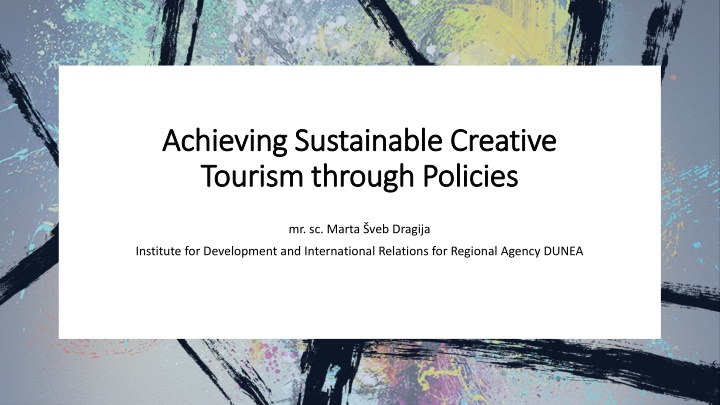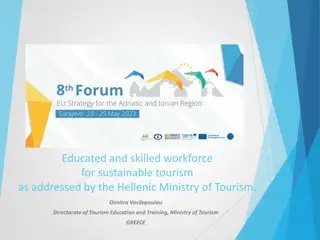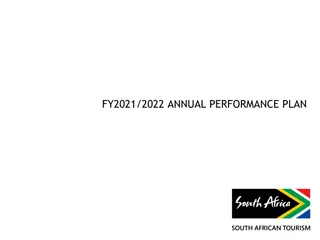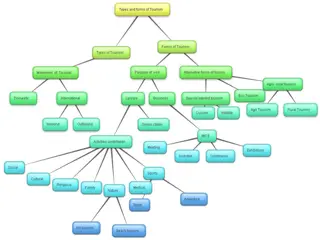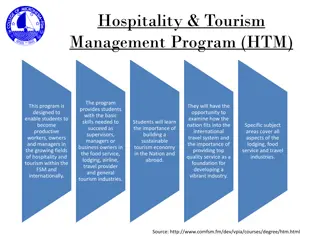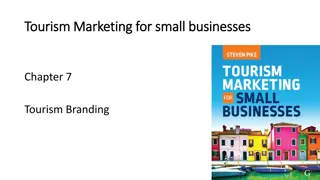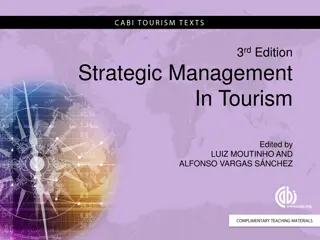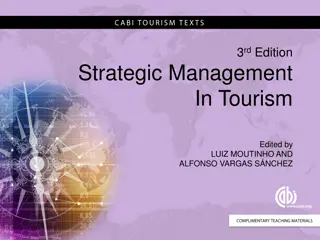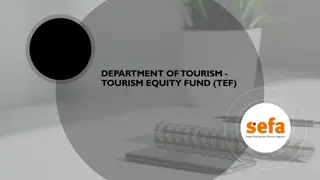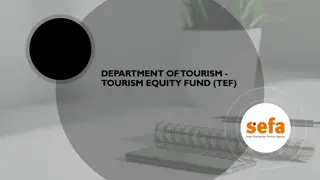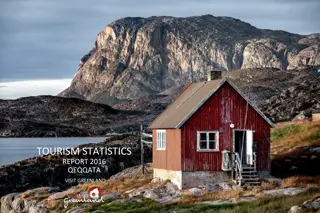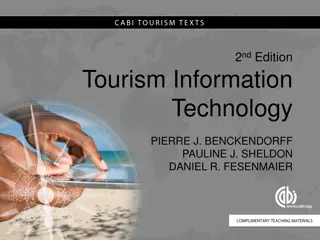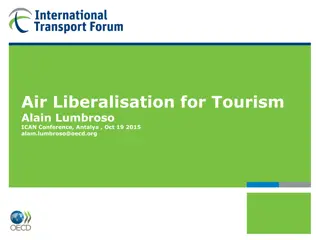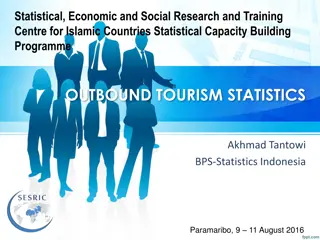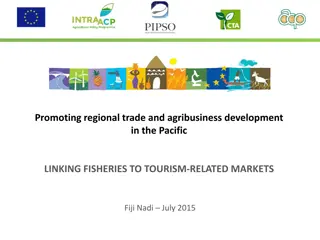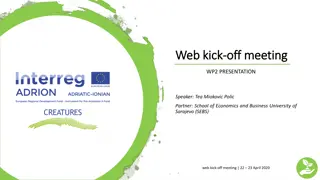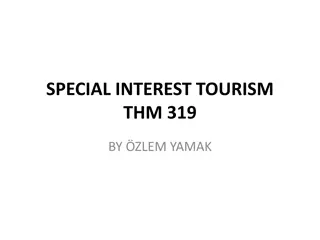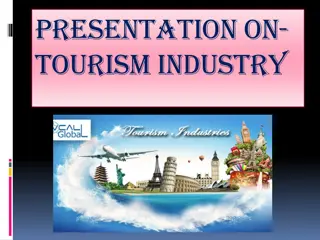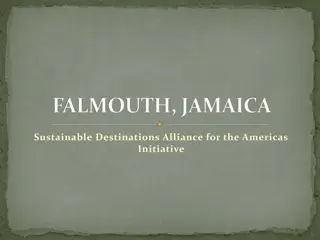Sustainable Creative Tourism Policies for Regional Development
Engage in sustainable creative tourism policies to support cultural heritage preservation, boost sustainable tourism development, and enhance intersectoral cooperation in the ADRION region. Recommendations include legal frameworks for CCIs, decentralization, and diversification of the economy.
Download Presentation

Please find below an Image/Link to download the presentation.
The content on the website is provided AS IS for your information and personal use only. It may not be sold, licensed, or shared on other websites without obtaining consent from the author.If you encounter any issues during the download, it is possible that the publisher has removed the file from their server.
You are allowed to download the files provided on this website for personal or commercial use, subject to the condition that they are used lawfully. All files are the property of their respective owners.
The content on the website is provided AS IS for your information and personal use only. It may not be sold, licensed, or shared on other websites without obtaining consent from the author.
E N D
Presentation Transcript
Achieving Sustainable Creative Achieving Sustainable Creative Tourism through Policies Tourism through Policies mr. sc. Marta veb Dragija Institute for Development and International Relations for Regional Agency DUNEA
IRMO engagement in the project 1. Policy recommendations for CCI SMEs and start-ups with a key role in preserving and valorizing cultural heritage and supporting the development of sustainable tourism; 2. Common innovative indicators, methods and tools for assessing the impact of CCIs on the preservation of cultural heritage and the promotion of sustainable experience tourism; 3. Legal recommendations aimed at strengthening intersectoral and multilevel cooperation between CCIs, cultural heritage and tourism in Croatia; 4. Legal recommendations aimed at strengthening intersectoral and multilevel cooperation between CCIs, cultural heritage and tourism in the area of the ADRION Program; 5. Sectoral analysis (tourism) for the area of Dubrovnik-Neretva County; 6. Feasibility study of the local pilot actions for the area of Dubrovnik-Neretva County (cost-benefit analysis and economic-financial sustainability analysis.
The general character of the policy recommendations is informing the decision-makers of policy options that are analytically grounded. Why: specific issues, aims, needs, aspirations in particular area, field, etc. A reference point in facilitating future policy-making in the CREATURES project partner countries (Albania, Bosnia and Herzegovina, Croatia, Italy and Slovenia) Policy recommendations Thematic scope: cultural and creative industries (CCIs) Suggesting integrated policy tools and measures for the long-term development and sustainability in the Adrion Region
CCI is not clearly defined and regulated in most project countries and this leads to confusing legal frameworks. The sector which stood out is film and audio-visual industry best regulated CCIs representation in a full policy cycle as an autonomous, concrete field of policy action. Cultural heritage is explicitly represented in legal frameworks and it has good policies and legalisation in most partner countries but the legal provision for the connection between cultural heritage (CH) and CCI is very weak. Italy has the strongest interrelation between CH and CCI. The links between CCI and heritage should be legally strengthened. In Croatia, Albania, and to some extent in Slovenia and BiH, decision making is highly centralised. Recommendation towards decentralization.
Sustainability is a worrying aspect in tourism in the legal frameworks. EU perspective 2021-2027, sustainability in tourism is encouraged (e.g. Croatian tourism policy, Strategy of Sustainable Tourism 2030) Usually sustainability is discussed within the framework of environmental protection and climate change but it entails other issues such as over tourism or even under tourism especially after COVID-19 Generally ADRION countries have overreliance on tourism industry. Policy recommendation goes to diversification of economy.
Impact of cultural/creative industries (CCIs) on cultural heritage preservation and valorisation and on tourism undeniable CCIs - a driver for growth, innovative spill overs in other industrial sectors, such as tourism, retail, and digital technologies (European Parliament, 2016); direct or indirect impact is seen in urban and regional development, territorial branding, economic growth, creative cities and tourism development, innovations, livability, and indirect investments In 2019 CCIs represented 4.4% of EU GDP - annual revenues of 643 billion and a total added value of 253 billion Common innovative indicators One of Europe s leading job providers - employing more than 7.6 million people CCIs growing faster (+2.6% per year since 2013) than the EU average (+2%) and represented a trade surplus of 8.6 billion in 2017 (the latest figures available) (Ernst & Young, 2019) COVID-19 big challenges (loss of over 30% of their turnover for 2020) but also opportunities (rise in online content, gaming, book sector) CCIs role in cultural heritage preservation - dynamism in the cultural heritage asset presentation, marketing, sales as well as preservation, especially in the digital environment CCIs role in tourism provision of experiences
Two types of indicators for assessing the impact of CCIs on the preservation of cultural heritage and the promotion of sustainable experience tourism: Indicators for CCI s impact assessment on cultural heritage on the policy level Heritage vibrancy; Creative economy; Enabling environment Indicators for CCI s impact assessment on cultural heritage on the project level Heritage preservation and protection enhancement; Heritage vibrancy and liveability; Financial, social, environmental and cultural sustainability of cultural heritage; Heritage products/services enhancement; Heritage marketing improvement; Heritage interpretation enhancement; Enhanced human resources management; Visitor management improvement; Local community participation
Indicators for CCIs impact assessment on cultural heritage on the policy level policy level Heritage area Heritage theme Indicators Creative economy Number of creative and knowledge-based jobs in the heritage sector Creative and knowledge-based jobs Number of CCI-related innovations in the heritage sector Number of CCI-related patents in the heritage sector Heritage innovation International branding of nationalheritage Number of international visitors to heritage sites Internationalisation of heritage
Indicators for CCIs impact assessment on cultural heritage on the project level Heritage area Heritage theme Indicators Financial, environmental and socio-cultural sustainability of cultural heritage Number of CCI-related funding sources (e.g. crowdfunding, CCI products retail, co-branding, CCI- related interpretation) Amount of CCI-related funds earned Number of CCI entrepreneurs/enterprises using heritage infrastructure, equipment and interpretation tools in their business operations (e.g. for advertising, film-making, video-clips and music recordings, space rentals, etc.) Number of digitally preserved heritage assets Number of activities of heritage digitisation Existence of CCI-related systems for environmental protection Existence of CCI-related systems for monitoring activities Financial sustainability Environmental sustainability Number of research projects related to heritage Number of researchers participating in heritage-related research activities Number of published papers, master s and doctoral dissertations related to heritage Number of CCI-related educational and awareness raising programs on heritage Number of educated participants in topics related to heritage Number of CCI events/activities at a heritage site Number of participants in CCI events/activities Cultural heritage presence in artworks, stories, films, music compositions, design, etc. Number of artists and CCI workers using heritage infrastructure for cultural creation Socio-cultural sustainability
Indicators for CCIs impact assessment on XP tourism Indicators for CCI s impact assessment on sustainable experiential tourism on the policy level Tourism sustainability; Tourism experiences. Indicators for CCI s impact assessment on sustainable experiential tourism on the project level Financial, social, environmental and cultural sustainability of tourism programmes; Tourism infrastructure improvement; Tourism products/services enhancement; Tourism marketing improvement; Market/visitor development; Enhanced human resources management; Tourists management improvement; Local community participation and interaction with tourists
Indicators for CCIs impact assessment on sustainable experiential tourism on the policy level policy level Tourism area Tourism experiences Tourism theme Tourism infrastructure improvement Indicators Number of CCIs used in the construction/enhancement of tourism buildings (e.g. architecture, design, music, visual arts, ICT, etc.) Number of local CCI SMEs/start-ups engaged in the construction/enhancement of tourism buildings Number of new/enhanced CCI products/services related to tourism (e.g. films, books, designs, musical pieces, creative gastronomy, cultural tourism routes, experiences, etc.) Number of tourists participating in/consuming CCI tourism-related activities (e.g. music festivals, exhibitions, performing arts shows, cultural tourism routes etc.) Number of CCI-related experiential tourism products/services sold/used Use of CCIs in experiential branding and market reach Experiential tourism products/services Marketing and market development
Indicators for CCIs impact assessment on sustainable experiential tourism on the project level project level Tourism area Enhanced human resourcesmanagement Tourism theme Education and training for sustainable experiential tourism Indicators Number of tourism workers trained in experiential tourism (e.g. topics: theming, positive and negative cues in experience design, experiential souvenirs, engagement of the senses, emotional branding, etc.) Use of CCI-related human resources management tools in tourism (e.g. software) Level of effectiveness of CCI-related human resources management tools in tourism Number of new CCI-related tourism job openings Employees
Sustainable heritage management entails a number of steps (from preservation, product development, financing, marketing,human resource management to presentation and interpretation) Challenges in proposing the indicators Balance between economic, socio-cultural and environmental sustainability Can an economic gain come before preservation of heritage values? Can use of a heritage asset come before environmental protection?, etc.
